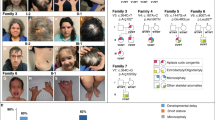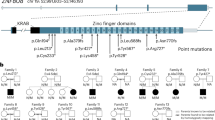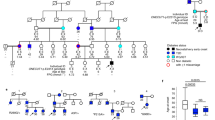Abstract
Johanson-Blizzard syndrome (OMIM 243800) is an autosomal recessive disorder that includes congenital exocrine pancreatic insufficiency, multiple malformations such as nasal wing aplasia, and frequent mental retardation1. We mapped the disease-associated locus to chromosome 15q14–21.1 and identified mutations, mostly truncating ones, in the gene UBR1 in 12 unrelated families with Johanson-Blizzard syndrome. UBR1 encodes one of at least four functionally overlapping E3 ubiquitin ligases of the N-end rule pathway, a conserved proteolytic system whose substrates include proteins with destabilizing N-terminal residues2,3,4,5. Pancreas of individuals with Johanson-Blizzard syndrome did not express UBR1 and had intrauterine-onset destructive pancreatitis. In addition, we found that Ubr1−/− mice, whose previously reported phenotypes include reduced weight and behavioral abnormalities6,7, had an exocrine pancreatic insufficiency, with impaired stimulus-secretion coupling and increased susceptibility to pancreatic injury. Our findings indicate that deficiency of UBR1 perturbs the pancreas' acinar cells and other organs, presumably owing to metabolic stabilization of specific substrates of the N-end rule pathway.
This is a preview of subscription content, access via your institution
Access options
Subscribe to this journal
Receive 12 print issues and online access
$209.00 per year
only $17.42 per issue
Buy this article
- Purchase on Springer Link
- Instant access to full article PDF
Prices may be subject to local taxes which are calculated during checkout




Similar content being viewed by others
References
Johanson, A. & Blizzard, R. A syndrome of congenital aplasia of the alae nasi, deafness, hypothyroidism, dwarfism, absent permanent teeth, and malabsorption. J. Pediatr. 79, 982–987 (1971).
Kwon, Y.T. et al. An essential role of N-terminal arginylation in cardiovascular development. Science 297, 96–99 (2002).
Tasaki, T. et al. A family of mammalian E3 ubiquitin ligases that contain the UBR box motif and recognize N-degrons. Mol. Cell. Biol. 25, 7120–7136 (2005).
Varshavsky, A. The N-end rule: functions, mysteries, uses. Proc. Natl. Acad. Sci. USA 93, 12142–12149 (1996).
Bachmair, A., Finley, D. & Varshavsky, A. In vivo half-life of a protein is a function of its amino-terminal residue. Science 234, 179–186 (1986).
Kwon, Y.T. et al. Female lethality and apoptosis of spermatocytes in mice lacking the UBR2 ubiquitin ligase of the N-end rule pathway. Mol. Cell. Biol. 23, 8255–8271 (2003).
Kwon, Y.T., Xia, Z., Davydov, I.V., Lecker, S.H. & Varshavsky, A. Construction and analysis of mouse strains lacking the ubiquitin ligase UBR1 (E3alpha) of the N-end rule pathway. Mol. Cell. Biol. 21, 8007–8021 (2001).
Daentl, D.L., Frias, J.L., Gilbert, E.F. & Opitz, J.M. The Johanson-Blizzard syndrome: case report and autopsy findings. Am. J. Med. Genet. 3, 129–135 (1979).
Guzman, C. & Carranza, A. Two siblings with exocrine pancreatic hypoplasia and orofacial malformations (Donlan syndrome and Johanson-Blizzard syndrome). J. Pediatr. Gastroenterol. Nutr. 25, 350–353 (1997).
Moeschler, J.B., Polak, M.J., Jenkins, J.J. III & Amato, R.S. The Johanson-Blizzard syndrome: a second report of full autopsy findings. Am. J. Med. Genet. 26, 133–138 (1987).
Rudnik-Schoneborn, S. et al. [Johanson-Blizzard syndrome]. Klin. Padiatr. 203, 33–38 (1991).
Swanenburg de Veye, H.F., Heineman-de-Boer, J.A. & Beemer, F.A. A child of high intelligence with the Johanson-Blizzard syndrome. Genet. Couns. 2, 21–25 (1991).
Vanlieferinghen, P.H., Borderon, C., Francannet, C.H., Gembara, P. & Dechelotte, P. Johanson-Blizzard syndrome. a new case with autopsy findings. Genet. Couns. 12, 245–250 (2001).
Vieira, M.W. et al. [Johanson-Blizzard syndrome: the importance of differential diagnostic in pediatrics.]. J. Pediatr. (Rio J.) 78, 433–436 (2002).
Zerres, K. & Holtgrave, E.A. The Johanson-Blizzard syndrome: report of a new case with special reference to the dentition and review of the literature. Clin. Genet. 30, 177–183 (1986).
Cuschieri, A. Anorectal anomalies associated with or as part of other anomalies. Am. J. Med. Genet. 110, 122–130 (2002).
Turner, G.C., Du, F. & Varshavsky, A. Peptides accelerate their uptake by activating a ubiquitin-dependent proteolytic pathway. Nature 405, 579–583 (2000).
Pickart, C.M. Back to the future with ubiquitin. Cell 116, 181–190 (2004).
Hershko, A., Ciechanover, A. & Varshavsky, A. The ubiquitin system. Nat. Med. 6, 1073–1081 (2000).
Ciechanover, A. & Schwartz, A.L. The ubiquitin system: pathogenesis of human diseases and drug targeting. Biochim. Biophys. Acta 1695, 3–17 (2004).
Jones, N.L., Hofley, P.M. & Durie, P.R. Pathophysiology of the pancreatic defect in Johanson-Blizzard syndrome: a disorder of acinar development. J. Pediatr. 125, 406–408 (1994).
Halangk, W. et al. Trypsin activity is not involved in premature, intrapancreatic trypsinogen activation. Am. J. Physiol. Gastrointest. Liver Physiol. 282, G367–G374 (2002).
Halangk, W. et al. Role of cathepsin B in intracellular trypsinogen activation and the onset of acute pancreatitis. J. Clin. Invest. 106, 773–781 (2000).
Yin, J., Kwon, Y.T., Varshavsky, A. & Wang, W. RECQL4, mutated in the Rothmund-Thomson and RAPADILINO syndromes, interacts with ubiquitin ligases UBR1 and UBR2 of the N-end rule pathway. Hum. Mol. Genet. 13, 2421–2430 (2004).
Kruger, B., Lerch, M.M. & Tessenow, W. Direct detection of premature protease activation in living pancreatic acinar cells. Lab. Invest. 78, 763–764 (1998).
Mayerle, J. et al. Up-regulation, nuclear import, and tumor growth stimulation of the adhesion protein p120 in pancreatic cancer. Gastroenterology 124, 949–960 (2003).
Kukor, Z. et al. Presence of cathepsin B in the human pancreatic secretory pathway and its role in trypsinogen activation during hereditary pancreatitis. J. Biol. Chem. 277, 21389–21396 (2002).
Xie, Y. & Varshavsky, A. The E2–E3 interaction in the N-end rule pathway: the RING-H2 finger of E3 is required for the synthesis of multiubiquitin chain. EMBO J. 18, 6832–6844 (1999).
Zeth, K. et al. Structural analysis of the adaptor protein ClpS in complex with the N-terminal domain of ClpA. Nat. Struct. Biol. 9, 906–911 (2002).
Kwon, Y.T. et al. The mouse and human genes encoding the recognition component of the N-end rule pathway. Proc. Natl. Acad. Sci. USA 95, 7898–7903 (1998).
Acknowledgements
We thank all participating families for making this study possible; A. Diem, E. Dazert and S. Balk for technical assistance; and G. Nürnberg for lod score calculations. This research was supported by grants from the Marohn Foundation of the University of Erlangen-Nuremberg and from the German Research Foundation to M.Z. and A.R., from the German Research Foundation and the Deutsche Krebshilfe to M.M.L. and J.M. and from the US National Institutes of Health and the Ellison Medical Foundation to A.V. and Y.T.K.
Author information
Authors and Affiliations
Corresponding author
Ethics declarations
Competing interests
The authors declare no competing financial interests.
Supplementary information
Supplementary Fig. 1
Pedigrees of JBS families (JBS01-JBS13) included in the study. (PDF 74 kb)
Supplementary Fig. 2
Expression analysis of UBR1 and UBR2 mRNA. (PDF 828 kb)
Supplementary Table 1
Two-point lod score analysis for the JBS locus on chromosome 15q14-15q21. (PDF 94 kb)
Supplementary Table 2
Exon-flanking primers used for PCR amplification and sequencing of human UBR1. (PDF 101 kb)
Rights and permissions
About this article
Cite this article
Zenker, M., Mayerle, J., Lerch, M. et al. Deficiency of UBR1, a ubiquitin ligase of the N-end rule pathway, causes pancreatic dysfunction, malformations and mental retardation (Johanson-Blizzard syndrome). Nat Genet 37, 1345–1350 (2005). https://doi.org/10.1038/ng1681
Received:
Accepted:
Published:
Issue Date:
DOI: https://doi.org/10.1038/ng1681
This article is cited by
-
Insights into the recognition mechanism in the UBR box of UBR4 for its specific substrates
Communications Biology (2023)
-
Structural insights into Ubr1-mediated N-degron polyubiquitination
Nature (2021)
-
A 3D system to model human pancreas development and its reference single-cell transcriptome atlas identify signaling pathways required for progenitor expansion
Nature Communications (2021)
-
Early trypsin activation develops independently of autophagy in caerulein-induced pancreatitis in mice
Cellular and Molecular Life Sciences (2020)
-
Alternative cleavage and polyadenylation of genes associated with protein turnover and mitochondrial function are deregulated in Parkinson’s, Alzheimer’s and ALS disease
BMC Medical Genomics (2019)



